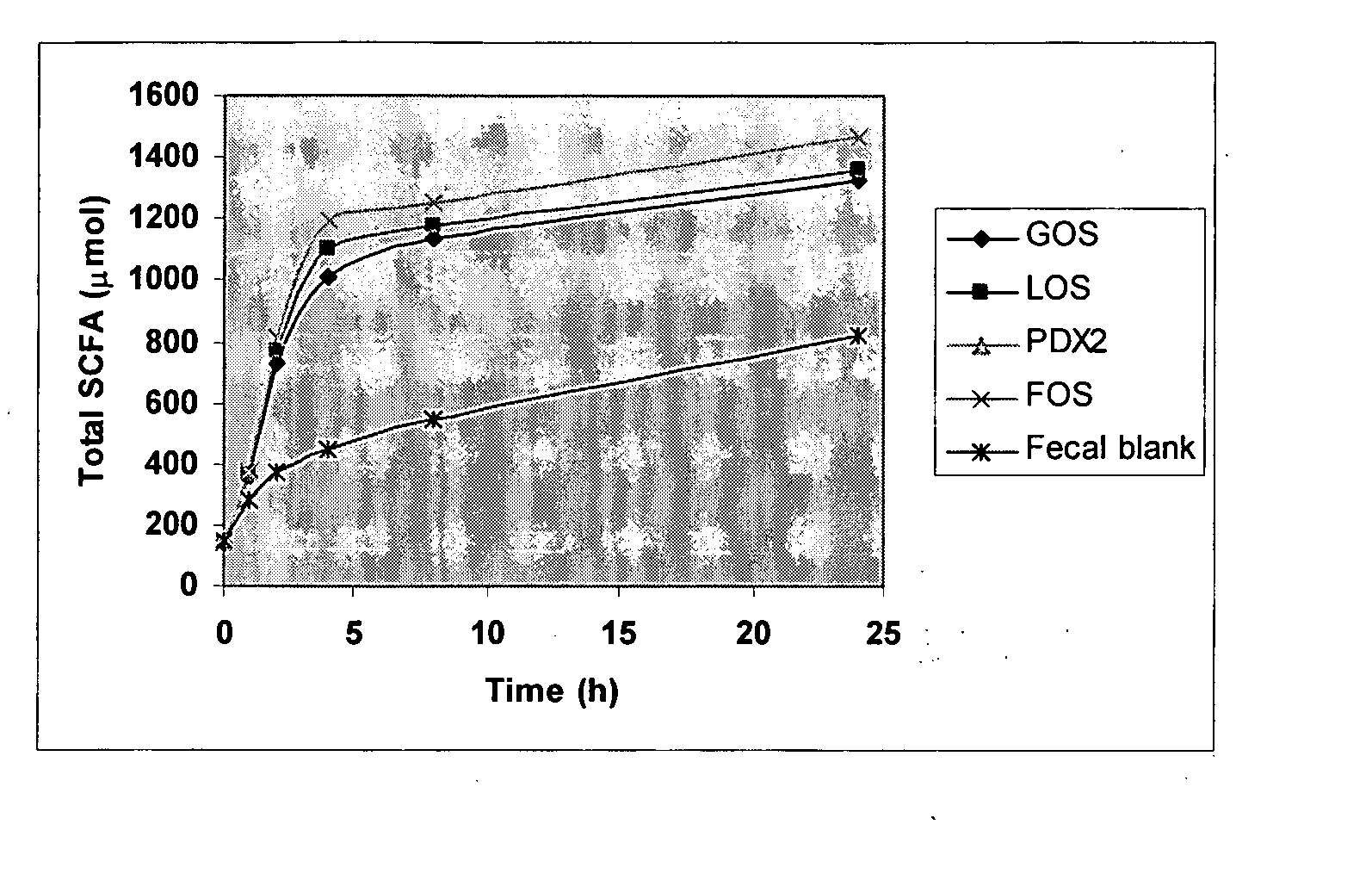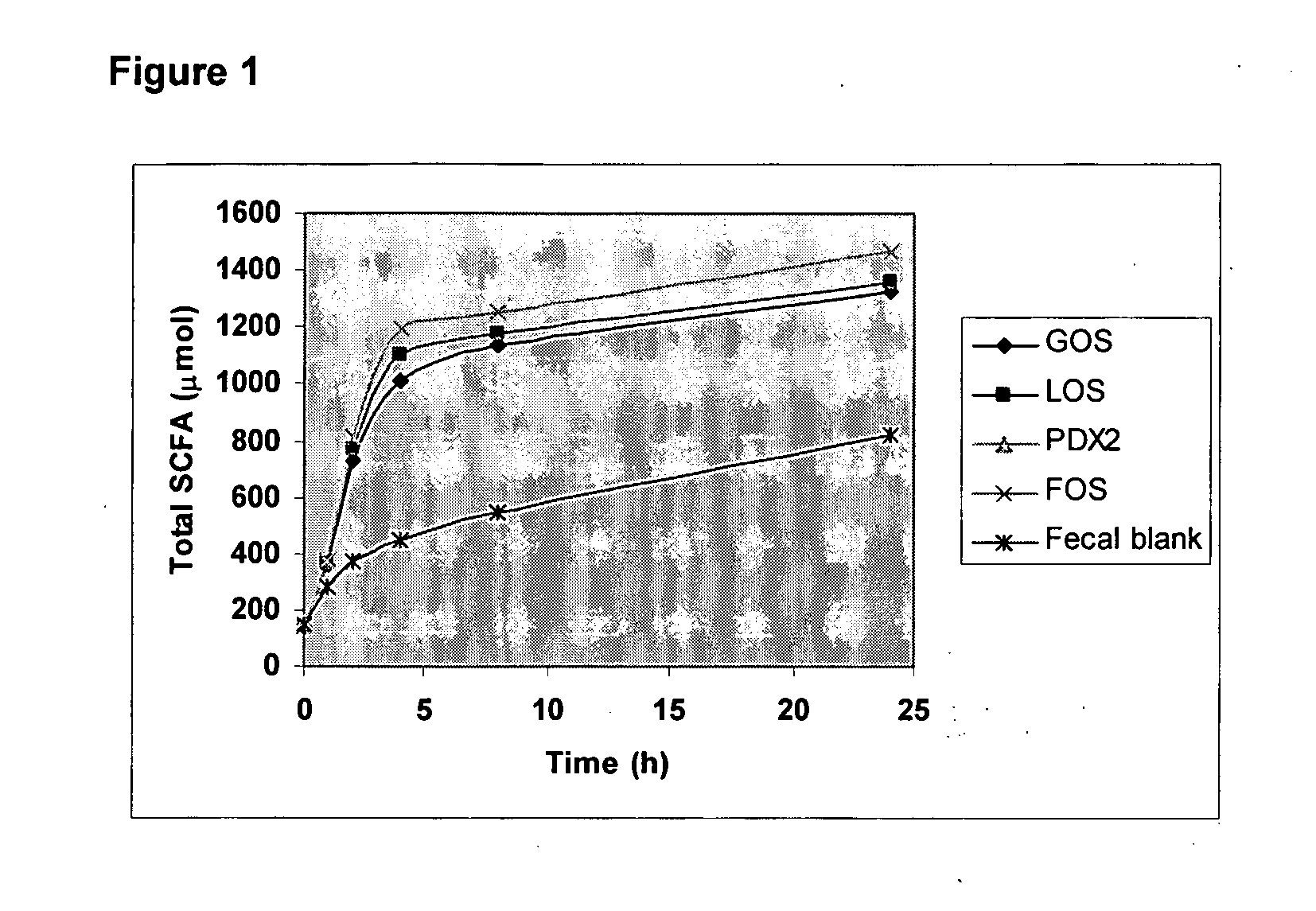Method for simulating the functional attributes of human milk oligosaccharides in formula-fed infants
a technology of functional attributes and human milk, which is applied in the field of simulating the functional attributes of human milk oligosaccharides in infants, can solve the problems of not producing a similar scfa profile, affecting the scfa production of infant formula, and affecting the scfa production rate, so as to reduce the rate and extent of prebiotic fermentation, increase the level of acetate, and reduce the amount of butyrate
- Summary
- Abstract
- Description
- Claims
- Application Information
AI Technical Summary
Benefits of technology
Problems solved by technology
Method used
Image
Examples
example 1
[0088] This example illustrates the in vitro fecal fermentation model utilized in the present invention. The fecal fermentation model in vitro mimics the action of the colon microbiota of infants. During fermentation, carbohydrates are consumed and SCFA and gases are produced. After fermentation, an analysis of the effect of the prebiotics on the populations and genera of microorganisms present can be accomplished.
[0089] The individual carbohydrates which were studied are set forth in Table 1.
TABLE 1Individual CarbohydratesGOS: Vivinal GOS: Deb. No. 00026961 Borculo Domo Ingredients;received 09 / 17 / 02; purity 95.1%LOS: Morinaga Lactulose Anhydride: MLC-A(F), Lot No. FRDL020926;Morinaga Milk Industry Co. Ltd; received 10 / 4 / 02; purity 97%PDX: Sta-Lite III PDX: Lot No. DZ2K0351913; A. E. StaleyFOS: Raftilose P95 Fructo-oligosaccharides: Lot No. PCAB022B02;Raffinerie Notre-Dame / Orafti SA; received 9 / 6 / 02; Purity 95.1%PDX2: Litesse ® Ultra ™ PDX: high molecular-weight polymer, max22 00...
example 2
[0094] This example illustrates the materials and methods necessary to determine the effectiveness of polydextrose as a prebiotic for formula-fed infants. Specifically, this example illustrates the materials and methods necessary to analyze SCFAs and gases.
[0095] SCFAs were extracted with diethyl ether and analyzed with gas chromatography as described by Karppinen, et al., which is hereby incorporated by reference in its entirety. Karppinen S., et al., In Vitro Fermentation of Polysaccharides of Rye, Wheat, and Oat Brans and Inulin by Human Faecal Bacteria, J. Sci. Food Agric. 80:1469-76 (2000). Gases (hydrogen, carbon dioxide, methane, hydrogen disulfide, and oxygen as a quality control) were analyzed isothermally at 30° C. using a static headspace technique by gas chromatography according to Karppinen, et al. Id.
example 3
[0096] This example illustrates the effect of PDX on the in vitro SCFA profile produced by the infant colon microbiota. FIGS. 1 and 2 illustrate that the rate of fermentation varies among different prebiotics. The production of total SCFA (a sum of acetic, propionic and butyric acids) is shown in FIG. 1. A decrease in pH, shown in FIG. 2, is also an indication of SCFA production.
[0097] As can be seen in the figures, PDX2 is a slowly fermentable carbohydrate, whereas FOS, GOS and LOS were fermented fast and completely. The fermentation rate of PDX2 was comparable to cereal dietary fibers. Not only was PDX2 fermented at the slowest initial rate, but the extent of fermentation was only slightly above the fecal blank. In contrast, the fermentation rate of FOS was so rapid that it was consumed almost completely within the first sampling time points and produced the highest amount of SCFAs among prebiotics tested.
[0098] As shown in FIG. 3-5, PDX2 fermentation results in the highest prop...
PUM
| Property | Measurement | Unit |
|---|---|---|
| pH | aaaaa | aaaaa |
| feed flow rate | aaaaa | aaaaa |
| pH | aaaaa | aaaaa |
Abstract
Description
Claims
Application Information
 Login to View More
Login to View More - R&D
- Intellectual Property
- Life Sciences
- Materials
- Tech Scout
- Unparalleled Data Quality
- Higher Quality Content
- 60% Fewer Hallucinations
Browse by: Latest US Patents, China's latest patents, Technical Efficacy Thesaurus, Application Domain, Technology Topic, Popular Technical Reports.
© 2025 PatSnap. All rights reserved.Legal|Privacy policy|Modern Slavery Act Transparency Statement|Sitemap|About US| Contact US: help@patsnap.com



